心境障碍(英文)
- 格式:ppt
- 大小:1.16 MB
- 文档页数:85

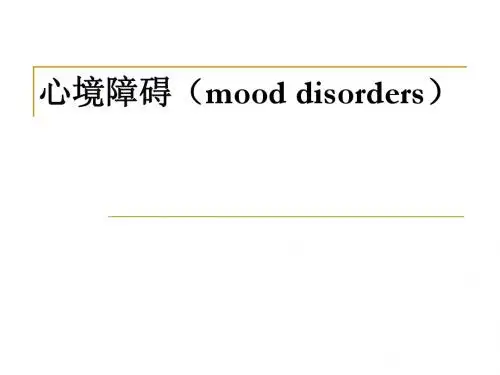
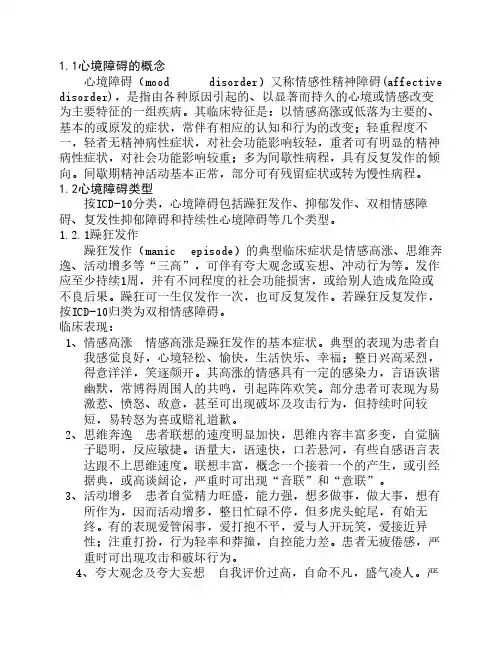
1.1心境障碍的概念心境障碍(mood disorder)又称情感性精神障碍(affective disorder),是指由各种原因引起的、以显著而持久的心境或情感改变为主要特征的一组疾病。
其临床特征是:以情感高涨或低落为主要的、基本的或原发的症状,常伴有相应的认知和行为的改变;轻重程度不一,轻者无精神病性症状,对社会功能影响较轻,重者可有明显的精神病性症状,对社会功能影响较重;多为间歇性病程,具有反复发作的倾向。
间歇期精神活动基本正常,部分可有残留症状或转为慢性病程。
1.2心境障碍类型按ICD-10分类,心境障碍包括躁狂发作、抑郁发作、双相情感障碍、复发性抑郁障碍和持续性心境障碍等几个类型。
1.2.1躁狂发作躁狂发作(manic episode)的典型临床症状是情感高涨、思维奔逸、活动增多等“三高”,可伴有夸大观念或妄想、冲动行为等。
发作应至少持续1周,并有不同程度的社会功能损害,或给别人造成危险或不良后果。
躁狂可一生仅发作一次,也可反复发作。
若躁狂反复发作,按ICD-10归类为双相情感障碍。
临床表现:1、情感高涨 情感高涨是躁狂发作的基本症状。
典型的表现为患者自我感觉良好,心境轻松、愉快,生活快乐、幸福;整日兴高采烈,得意洋洋,笑逐颜开。
其高涨的情感具有一定的感染力,言语诙谐幽默,常博得周围人的共鸣,引起阵阵欢笑。
部分患者可表现为易激惹、愤怒、敌意,甚至可出现破坏及攻击行为,但持续时间较短,易转怒为喜或赔礼道歉。
2、思维奔逸 患者联想的速度明显加快,思维内容丰富多变,自觉脑子聪明,反应敏捷。
语量大,语速快,口若悬河,有些自感语言表达跟不上思维速度。
联想丰富,概念一个接着一个的产生,或引经据典,或高谈阔论,严重时可出现“音联”和“意联”。
3、活动增多 患者自觉精力旺盛,能力强,想多做事,做大事,想有所作为,因而活动增多,整日忙碌不停,但多虎头蛇尾,有始无终。
有的表现爱管闲事,爱打抱不平,爱与人开玩笑,爱接近异性;注重打扮,行为轻率和莽撞,自控能力差。
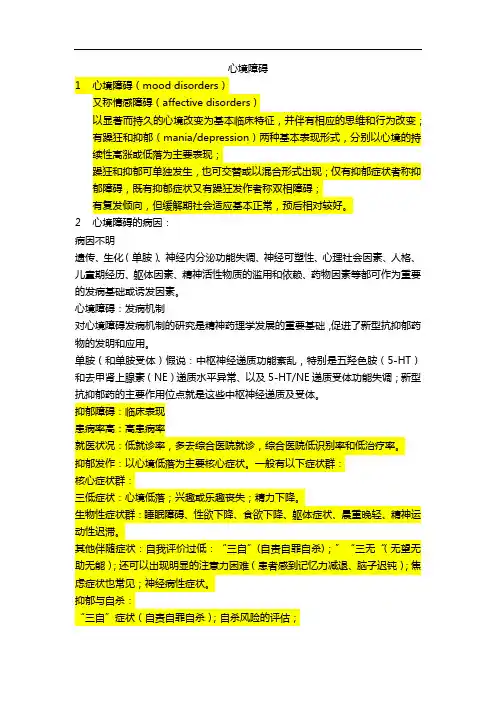
心境障碍1心境障碍(mood disorders)又称情感障碍(affective disorders)以显著而持久的心境改变为基本临床特征,并伴有相应的思维和行为改变;有躁狂和抑郁(mania/depression)两种基本表现形式,分别以心境的持续性高涨或低落为主要表现;躁狂和抑郁可单独发生,也可交替或以混合形式出现;仅有抑郁症状者称抑郁障碍,既有抑郁症状又有躁狂发作者称双相障碍;有复发倾向,但缓解期社会适应基本正常,预后相对较好。
2心境障碍的病因:病因不明遗传、生化(单胺)、神经内分泌功能失调、神经可塑性、心理社会因素、人格、儿童期经历、躯体因素、精神活性物质的滥用和依赖、药物因素等都可作为重要的发病基础或诱发因素。
心境障碍:发病机制对心境障碍发病机制的研究是精神药理学发展的重要基础,促进了新型抗抑郁药物的发明和应用。
单胺(和单胺受体)假说:中枢神经递质功能紊乱,特别是五羟色胺(5-HT)和去甲肾上腺素(NE)递质水平异常、以及5-HT/NE递质受体功能失调;新型抗抑郁药的主要作用位点就是这些中枢神经递质及受体。
抑郁障碍:临床表现患病率高:高患病率就医状况:低就诊率,多去综合医院就诊,综合医院低识别率和低治疗率。
抑郁发作:以心境低落为主要核心症状。
一般有以下症状群:核心症状群:三低症状:心境低落;兴趣或乐趣丧失;精力下降。
生物性症状群:睡眠障碍、性欲下降、食欲下降、躯体症状、晨重晚轻、精神运动性迟滞。
其他伴随症状:自我评价过低:“三自”(自责自罪自杀);”“三无“(无望无助无能);还可以出现明显的注意力困难(患者感到记忆力减退、脑子迟钝);焦虑症状也常见;神经病性症状。
抑郁与自杀:“三自”症状(自责自罪自杀);自杀风险的评估;自杀的预防:告诉患者亲友有关该疾病自杀率高的特征;避免危险物品和场合,对有消极倾向者需严防自杀。
抑郁障碍:诊断标准核心症状至少两条:心境低落;兴趣和愉悦感丧失;精力减低或过度疲劳;其他症状:思维或注意力的能力降低;自我评价和自信降低;自罪观念和无价值感;精神运动性迟滞或激越;自伤、自杀观念或行为;睡眠障碍;食欲改变/伴体重变化。
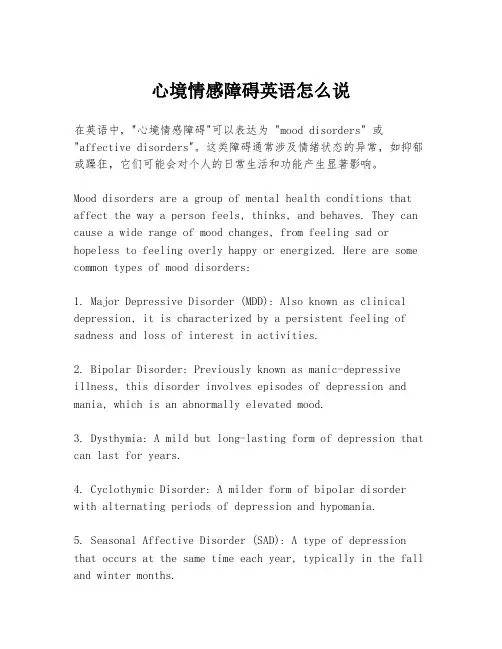
心境情感障碍英语怎么说在英语中,"心境情感障碍"可以表达为 "mood disorders" 或"affective disorders"。
这类障碍通常涉及情绪状态的异常,如抑郁或躁狂,它们可能会对个人的日常生活和功能产生显著影响。
Mood disorders are a group of mental health conditions that affect the way a person feels, thinks, and behaves. They can cause a wide range of mood changes, from feeling sad or hopeless to feeling overly happy or energized. Here are some common types of mood disorders:1. Major Depressive Disorder (MDD): Also known as clinical depression, it is characterized by a persistent feeling of sadness and loss of interest in activities.2. Bipolar Disorder: Previously known as manic-depressive illness, this disorder involves episodes of depression and mania, which is an abnormally elevated mood.3. Dysthymia: A mild but long-lasting form of depression that can last for years.4. Cyclothymic Disorder: A milder form of bipolar disorder with alternating periods of depression and hypomania.5. Seasonal Affective Disorder (SAD): A type of depression that occurs at the same time each year, typically in the fall and winter months.6. Premenstrual Dysphoric Disorder (PMDD): A severe form of premenstrual syndrome (PMS) that can cause significant mood swings and depression.7. Postpartum Depression: A type of depression that many women experience after giving birth.These disorders are often treated with a combination of medication, therapy, and lifestyle changes. It's important for individuals experiencing mood disorders to seek professional help to manage their symptoms and improve their quality of life.。
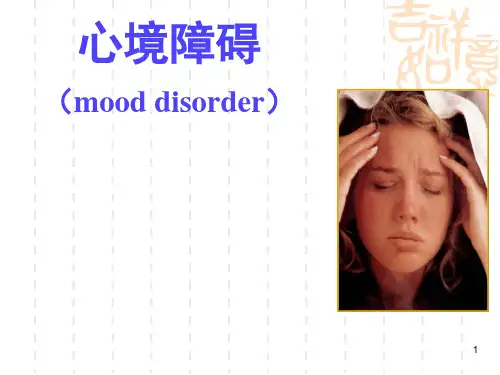
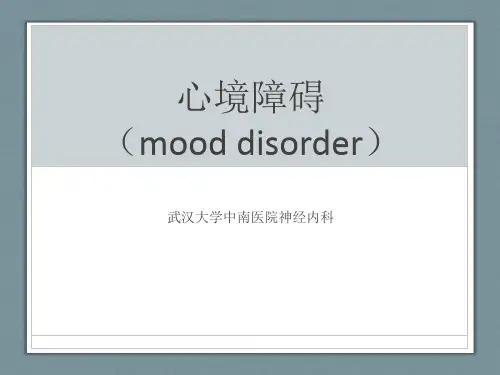

心境障碍名词解释心境障碍(MoodDisorders)是一种常见的精神疾病,它会对人的情感、思维、行为产生不利的影响,形成不良的心理及行为模式。
心境障碍并不一定是由外部因素引起的,它可能是由于内在心理因素,比如个人生活经历、家庭关系、社会风俗,以及自我意识观念等其他因素而产生的。
心境障碍中涉及几种主要疾病,包括抑郁症(Depression)、躁狂症(Mania)和双相情感障碍(Bipolar disorder)。
抑郁症是一种精神病,可以引起持久的情绪低落,失去对生活的兴趣,以及出现记忆力衰退和焦虑等症状,患者也可能会出现自杀或自暴自弃的行为。
躁狂症是另一种心境障碍,它会造成症状如:情绪过度激动、易燃易爆,或对某事物过度兴奋、易怒等现象。
双相情感障碍是又一种心境障碍,它会使患者内心极度活跃,精力充沛,但又会出现抑郁、焦虑、记忆力减退、思维迟钝等症状。
心境障碍会造成严重的影响,首先会对患者情绪产生影响,患者可能会感到心境低落,失去生活的兴趣,或出现记忆力衰退、焦虑情绪等现象,而这些症状可能进一步会对患者的行为产生负面影响,例如减少活动、变得轻易易怒等。
此外,心境障碍还会对患者的认知产生影响,患者可能出现思维迟钝、言语不清的情况,也可能出现认知功能受损,如语言、注意力或学习能力等受损。
要想治疗心境障碍,首先要让患者了解心境障碍,让患者发现自身的问题,了解自身的情绪及行为,以便能够采取有效措施来改变和解决心境障碍。
治疗心境障碍的方法有医学治疗、心理治疗、生理学治疗等,而每个患者在治疗过程中也应该采取有效的自我调节技巧,比如发挥正面思维、改变不良习惯等,以便改变负面心理情绪,减轻心境障碍的症状。
总之,心境障碍是一种常见的精神疾病,它可能是由于内在心理因素而产生的,对患者及其家属、朋友等外界因素都会造成很大的负面影响。
治疗心境障碍需要有效的治疗方法和自我调节技巧,因此,患者需要定期检查,及时发现问题,及时采取有效的治疗方案,以改善心境障碍带来的负面影响。
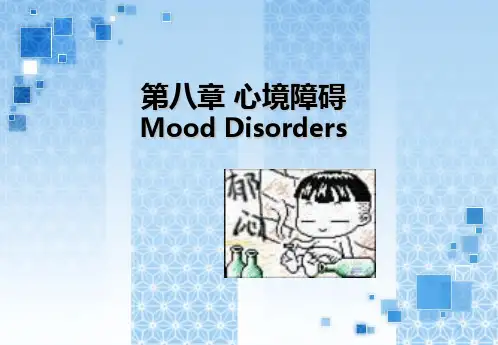
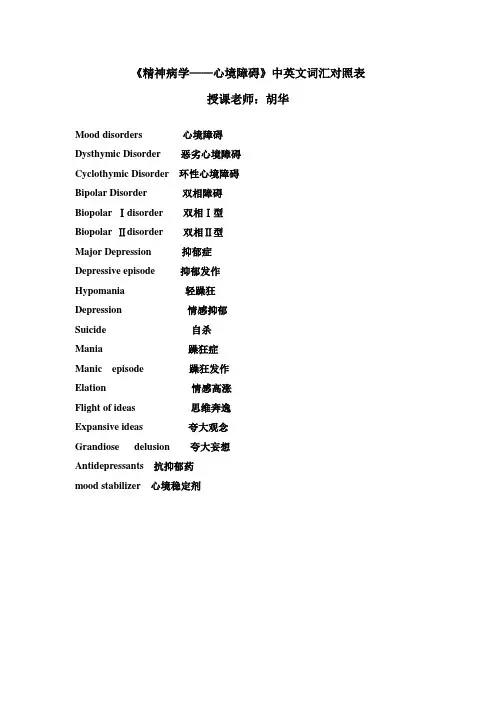

心境障碍(mood disorders),既往称为情感性精神病(affective psychoses)。
它是一组以心境(情感)显著而持久地高涨或低落为主要临床特征的精神障碍,常伴有相应的思维和行为改变。
心境障碍的表现具有很大的变异,较轻的可以是对某种负性生活事件的反应,重的则可成为一种严重的复发性甚至慢性致残性障碍。
病情重者可出现幻觉妄想等精神病性症状。
常反复发作,多数可缓解,少数残留症状或转为慢性。
这类精神障碍首次发病年龄多在16~30岁之间,15岁以前和60岁以后发病者均少见。
躁狂症的发病年龄一般比抑郁症早,女性比男性早。
女性抑郁症患病率高,但男性抑郁症自杀率较高。
有的心境障碍发病与应激性事件或生活处境有关。
急性或亚急性起病躁狂症以春末夏初发病较多,而抑郁症发病多见于秋冬季。
有些女病人发作与月经周期有关或在月经期病情加重。
临床上可分为抑郁发作、躁狂发作、双相障碍和持续性心境障碍4个类型。
抑郁的核心症状包括心境或情绪低落,兴趣缺乏以及乐趣丧失,这是抑郁的关键症状,诊断抑郁状态时至少应包括此3种症状中的1个。
心理症状群:抑郁发作包含许多心理学症状,可分为心理学伴随症状(焦虑、自责自罪、精神病性症状、认知症状以及自杀观念和行为,自知力等)和精神运动性症状(精神运动性兴奋与精神运动性激越等)。
躯体症状群:睡眠紊乱(失眠最常见),食欲紊乱,性功能减退,精力丧失,非特异性躯体症状如疼痛、周身不适、自主神经功能紊乱等。
抑郁发作的临床表现可有明显的个体差异,在青少年病人中非典型的表现尤为常见。
在某些病例中,心境的改变也可能被易激惹、酗酒、戏剧性行为或原有的恐惧强迫症状或疑病观念所掩盖。
尽管如此,某些症状对诊断抑郁发作具有重要意义,如对平素令人能体验到乐趣的个人爱好丧失兴趣和愉快感;对通常令人愉快的环境缺乏情感反应;较平时早醒2h或更多;早晨抑郁加重;肯定的精神运动性迟滞或激越;食欲明显下降;体重降低比1个月前减少5%或更多;性欲明显降低等,均应高度注意。